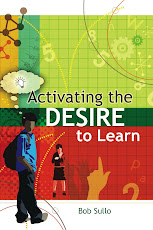The next few sentences are a challenge. I’d like to write
something that my audience will like. And I know what many of you want: a
recipe for dealing with kids who bully. The “right” thing to say. Some of you
may be wondering, “What’s the choice theory formula when faced with this
situation?”
Sorry to disappoint, but there is no magic bullet. Many
“experts” will promise you success if you follow their lock-step program. If
you’re naïve enough to settle for simplistic solutions to complex human issues,
there are plenty of purveyors of 21st century snake oil. I’m just
not one of them.
If you have conquered your disappointment and continued
reading, I can share two things that I always do when dealing with kids like
Jon. The first is to build and maintain a positive relationship with him. I
have dealt with many teachers over the years who have asked me in politically
incorrect language, “How do you connect positively with a jerk?” Apart from the
insensitivity of their language, the answer is really quite easy for me: I do everything I can to build a positive relationship with Jon and every
other kid, parent, teacher, etc because that’s my job! Whether it’s “natural” is irrelevant. Whether it's 'easy" is irrelevant. As a
professional educator, my job includes working with all students, including
those who “don’t deserve it” and who are more difficult to like.
Creating and maintaining a positive relationship with Jon is
not a one-shot deal. It’s an ongoing series of interactions that begins the
first time we meet. And it’s something so fundamentally important that it
serves as a backdrop to every interaction we have, including when he has
behaved poorly.
The other thing I do with a student like Jon in this
situation is to try to create (or explore if we have) a shared quality world
picture. Dr. Glasser has identified four primary patterns of interacting,
including counseling and managing. This is a situation that calls for managing.
As a manager, I have an agenda and my goal is to invite or enlist the other
person to embrace that same goal.
I don’t begin by asking Jon, “What do you want?” That question is perfectly appropriate in other contexts, but his
answer may take us far from where I want to go and, as a manager, I want to
structure the conversation carefully. I begin by asking, “Jon, do you know what
it is that I want?” I don’t threaten him. I don’t punish him. Sensing
that he is probably emotionally charged up at the moment, I ask him a question
that gets him thinking and less focused on himself.
This may sound strange, but it doesn’t especially matter to
me what Jon says. I have had situations where the poorly behaving student
correctly identified what I wanted. Other times, they have no clue. Sometimes
they express indifference. Whatever they say gives me information about their
current state of mind and willingness to engage with me. And whether they
correctly guess what I want or not, I have structured the conversation so I can
tell them.
“What I want is for this to be a safe environment. Does that
sound reasonable to you?
I have had countless interactions like this and I have never
had a student tell me that my goal is unreasonable.
“OK, so we agree that it’s reasonable to want a safe
environment. That’s what I want. Let me ask you, is that something you want as
well?”
More often than not, students tell me they want what I want
– a safe environment. When they do – and it’s important to me that they overtly
express their desire – I say something like, “It sounds like we want the same
thing. Since we’re on the same side, this should be easy.” I have taken a
student who might have entered my office seeing me as an adversary and we have
become allies, working toward a common goal.
There are rare instances when kids have told me that they
were not interested in a safe environment. I’m not there to argue. At that
moment, I’m not even especially interested in convincing them to change their
mind. I’m simply seeking clarity of intent. “Well, it looks as if you and I
want different things. You need to know that I’ll do everything I can to ensure
that our school is safe. You and I get along well, but that doesn’t
mean I’m going to tolerate behavior that interferes with my goal of making this
a safe school.”
Interestingly, the few times the conversation has taken this
turn, kids typically shift position. Once they see that I am willing and able to both
like them and hold them accountable for their actions, they usually decide to
cooperate.
Finally, when dealing with a student who bullies others, I
make sure I do two things. First, I enforce the rules of the school. It doesn’t
make any sense in having rules if they aren’t going to be enforced. Second, I
make sure I do everything in my power to teach the student a more responsible way to meet his needs. Imposing consequences without teaching a
better way to behave is a waste of time. Punishment doesn’t magically equip
kids with new, effective, responsible behaviors. That requires teaching. So
while I enforce the rules and impose any consequences the school handbook
includes, I also make sure to include a teaching component so the student
learns how to get what he wants without taking unfair advantage of other
students.
In summation, when dealing with kids who bully others, I
suggest:
- Beginning
by remembering your role and goal (Part I)
- Building
and maintaining a positive relationship with the offending student. (It’s
part of our role as professional educators.)
- Assessing
if you have a shared want/goal/quality world picture: a safe environment.
- Clearly
articulating what you want.
- Enforcing
school rules.
- Teaching
the offending student a more responsible way to meet his needs.
***
As always, if you enjoyed this and found it useful, please
send the link to your friends. Thanks.
Bob Sullo
PO Box 1336
Sandwich, MA 02563
For information about books by Bob Sullo and to schedule a
keynote, workshop, or series for your school, agency, or parent group visit
www.internalmotivation.net





